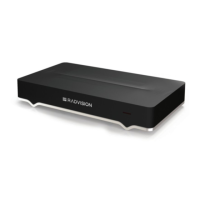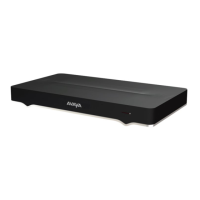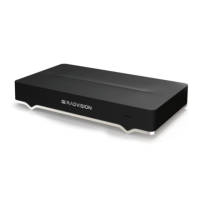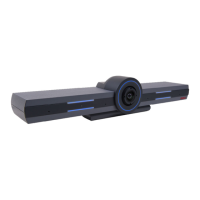© 2017 Avaya Inc. All rights reserved
Release Notes for Avaya Scopia® XT Series Known Issues | 41
to connect to the Internet the results could be not
accurate.
Telepresence triplet cannot
work properly (if configured
with dynamic IP addresses)
when their addresses changes.
When setting up a Telepresence system, it is
strongly recommended to use static IP addresses for
the three endpoints.
Telepresence higher than 8.3.X
cannot be calibrated or
configured using a previous
calibration application.
Connect to the Telepresence Master using a Web
Browser from your computer (Windows or Mac) and
download the updated package for the Calibration
application. The version of the application can be
checked by pressing F1 for Windows (or CMD+1 for
Mac) when the application is running.
Your recording can become
corrupted if USB key is
unplugged while a USB
recording is in progress.
Stop the recording before unplugging the USB key.
When recording the additional
monitor shows the same video
as the main monitor
Recording license cannot be
enabled on systems with CPU
version lower than 2.0
Save Recording status seems
correct but the file is not
available in AESR.
Verify that your Owner name and the Organization
ID are correct. Transfer status shown by XT is
relative to FTP transfer.
USB Recording in a telepresence
system will record only master
codec content and force a single
monitor scenario on the master.
To properly record a telepresence session, use
Network Recording
Snapshots & Web
Video
AT commands
When recording is active or the
HD1 monitor is duplicated, it is
not possible to select the single
source to snapshots. The
content of the whole screen will
be captured.
When XT is registered to or
managed by Scopia®
Management FP2, it could
connect to the wrong meeting if
invited by Mobile Link.
Upgrade Scopia® Management to 8.3.3.xx
When Screen Link is used as
main video during a call ( by
selecting DVI camera), Screen
Link is stopped when receiving a
presentation and the DVI input
is used in place of the Screen
Link
When Screen Link is used, it is
not possible to record to local
USB key. When recording, it is
not possible to activate Screen
Link
When Screen Link is used, audio
is not transmitted from PC/Mac
to XT
Screen Link is a replacement for the DVI cable. To
share audio from PC/Mac to XT, you need to use a
digital/analog audio physical connection.
When a DVI content is displayed
on XT or another Scopia®
Desktop client or Equinox Client
has an active Screen Link
connection with the same XT,
the Screen Link pairing will fail (
the endpoint is listed with
forbidden icon or manual
pairing will fail with "Endpoint
unavailable" message).
To activate Screen link from a different client,
terminate presentation on XT by pressing Present or
stop screen link from the client.
Presentation priority is DVI/Screen Link. You need to
unplug DVI to have XT show Screen Link content.
Please note that if you plug in DVI input while
Screen Link content is sent or shown, it will be
automatically stopped. The physical connection is
used instead of the screen link (physical DVI plug
has precedence over screen link).
Screen Link and
HD1 and DVI on
XT7000 with
Presentation
Content on HD1
enabled
When a DVI/HD1 content is
displayed on XT or another
Scopia® Desktop Client/Equinox
Client has an active Screen Link
connection with the same XT,
the Screen Link pairing will fail (
To activate Screen link from a different client,
terminate presentation on XT by pressing Present or
stop screen link from the client.
When Presentation Content is enabled on HD1, DVI
Input is used for presentation only if no input is
connected on HD1. Otherwise HD1 has the

